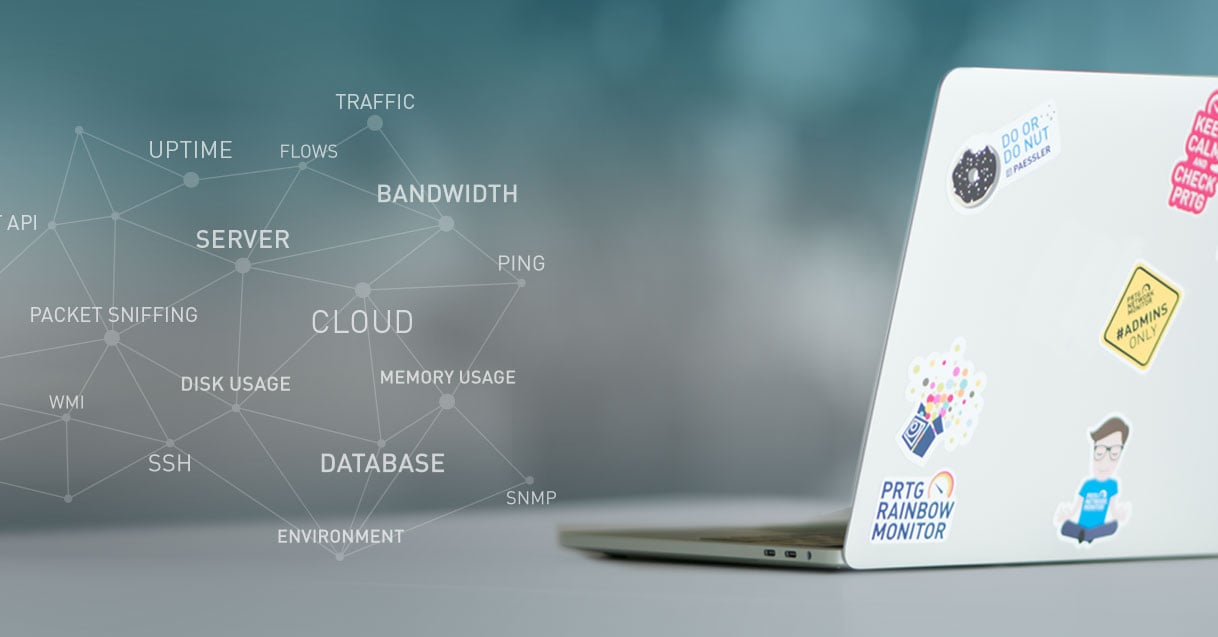Domain Name System (DNS) is an integral part of network infrastructure. As a result, DNS monitoring is critical for ensuring security and performance. Basic uptime checks aren't enough; advanced DNS monitoring can help prevent DNS spoofing, DNS cache poisoning and DDoS attacks. Monitor DNS records with PRTG's new DNS v2 sensor and track DNS performance and receive real-time notifications when issues occur.
DNS monitoring is more important than ever before. DNS-based cyber attacks increased 67% over the past year. Beyond uptime monitoring of server performance, modern IT teams need more granular DNS record monitoring. Teams require advanced capabilities to detect and prevent changes, DNS cache poisoning and other issues that can affect business continuity and impact end user experience.
Monitoring your DNS servers with PRTG provides continuous visibility into DNS service availability, response time and DNS performance. You can quickly isolate and troubleshoot when downtime or slow DNS response occurs before it causes local network issues and outages.
With the new DNS v2 sensor, it's now possible to not only monitor your DNS servers or public DNS servers while getting comprehensive statistics on them. It's also possible to monitor your records that are hosted on them.
👉 Download PRTG free trial and start monitoring your DNS records with the advanced DNS v2 sensor today.
DNS Security Threats: Why Real-Time Monitoring Matters
DNS poisoning and DNS spoofing attacks redirect unsuspecting users to a malicious website by hacking DNS servers and intercepting communications between a user and a DNS server. This happens by taking advantage of vulnerabilities in DNS configurations to compromise DNS queries and by tampering with DNS-based authentication.
In 2011, Brazil was hit with major DNS spoofing attacks caused havoc and installed malware on people's computers when users attempted to access legitimate sites like Google and Facebook. This was done by attacking the DNS cache and spoofing the DNS resolution.
DNS cache poisoning attacks are designed to alter the resolver with incorrect data. In this attack, DNS requests are redirected to servers operated by the attacker. With the DNS v2 sensor, you have better filter options for detecting DNS traffic for different record types: A records, AAAA records (IPv6 addresses), CNAME, MX, NS records, PTR, SOA records and TXT.
Add wildcard matching patterns (e.g. 127..1) or more than one filter value separated by a comma (172.217..1,172.217. *.2) to track a wide variety of values across multiple IP addresses and hostname combinations and detect unauthorized changes to your domain name.
DNS Monitoring Best Practices: Preventing Downtime and Security Threats
The DNS v2 sensor takes your performance monitoring to the next level. Paessler PRTG allows you to achieve observability of your complete DNS system rather than only monitoring server availability.
Main Features of the DNS v2 Sensor:
-
Support for Multiple Record Types – simultaneously monitor multiple DNS record types (A records, AAAA records (IPv6), CNAME, MX, NS records, PTR, SOA records, TXT)
-
Advanced filtering: filter on multiple values using wildcard patterns
-
Real-time notifications: Immediate alerts when DNS records change unexpectedly
-
Performance metrics: Track response time, latency, and DNS queries per second
-
Security-focused design: Built to detect DNS spoofing and cache poisoning attempts
-
API integrations: Connect with existing dashboards and monitoring systems
-
TCP and UDP support: Monitor both TCP and UDP DNS traffic protocols
The sensor allows you to configure the timeout values, which may go up to 900 seconds, as well as custom port settings to enable administrators to tune it according to the DNS server requirements in various network monitoring situations.
DNS v2 Sensor Configuration: Step-by-Step Security Setup
To implement comprehensive DNS monitoring, follow these configuration steps:
-
Device Configuration: Set up a device in PRTG with the IP address or hostname of your DNS server that hosts public records
-
Sensor Creation: Create your DNS v2 sensor specifying the DNS record to monitor
-
Record Type Selection: Choose from A records, AAAA, CNAME, MX, NS records, PTR, SOA records, or TXT based on your requirements
-
Filter Configuration: Create filters to detect unauthorized changes to domain name records
-
Alert Setup: Configure real-time notifications for immediate incident response
In this example, you will monitor an MX record for a top-level domain. You will create a filter that puts the sensor into a down state when the domain name changes, allowing you to be immediately notified of possible security incidents.

Why DNS v2 Sensor Outperforms Traditional DNS Monitoring
Typical DNS solutions are inadequate for complex and security-critical DNS infrastructures, and DNS v2 sensor overcomes key limitations of such tools in DNS services monitoring:
Performance Advantages:
-
Low CPU impact: Efficient monitoring without system resource degradation
-
Distributed monitoring: Support for remote probes across multiple locations
-
Scalable architecture: Handle thousands of DNS queries without performance loss
-
Real user monitoring: Track actual user experience impact from DNS resolution delays
Security Enhancements:
-
DDoS protection: Detect Distributed Denial of Service attacks targeting DNS infrastructure
-
SSL/TLS monitoring: Verify secure DNS traffic and authentication processes
-
Root servers monitoring: Track connectivity to critical name servers
-
Serial number tracking: Monitor SOA record changes for zone file integrity
DNS Performance Optimization Beyond Security
DNS performance directly impacts end user experience and application responsiveness. Poor DNS resolution times can cause significant latency issues that affect overall system performance.
Performance Monitoring Metrics:
-
Response time measurement across different record types
-
DNS cache efficiency and hit rates
-
Network routing optimization for DNS queries
-
Server performance analytics including CPU utilization
-
Synthetic monitoring for proactive issue detection
The DNS v2 sensor continuously captures these metrics. Administrators are better equipped to tune DNS infrastructure for optimum performance before users are affected. Real-time dashboards deliver immediate visibility into DNS traffic patterns and performance monitoring data.
Enterprise-Grade DNS Monitoring Scalability
Unlike simple DNS monitors that have issues in enterprise deployments, PRTG allows you to distribute your monitoring from multiple locations with the use of remote probes.
Scalability Features:
-
Multi-platform support: Monitor DNS services across Windows and other platforms
-
API integrations: Connect with existing SIEM and network monitoring systems
-
Custom dashboards: Create specialized views for different team requirements
-
Automated troubleshooting: Built-in troubleshoot capabilities for common DNS issues
-
Flexible pricing: Scalable pricing models that grow with your infrastructure
Advanced DNS Security and Compliance
Modern DNS monitoring must address sophisticated attack vectors while maintaining regulatory compliance. The DNS v2 sensor provides enterprise-grade security features:
Security Monitoring Capabilities:
-
DNS poisoning detection across multiple resolver systems
-
Cache poisoning prevention through record integrity verification
-
Hostname spoofing detection and alerting
-
IPv6 security monitoring for dual-stack environments
-
TTL manipulation detection to prevent cache timing attacks
👉 Ready to secure your DNS infrastructure? Download PRTG free trial and start monitoring your DNS records with the advanced DNS v2 sensor today.
Conclusion: Comprehensive DNS Infrastructure Protection
Simply tracking DNS uptime is an inefficient approach to DNS monitoring. Effective DNS monitoring is necessary in a modern IT infrastructure. Security and performance visibility requires DNS monitoring that can be actively monitored in real time.
PRTG's DNS v2 sensor delivers enterprise-grade DNS server monitoring with DNS server filtering, all supported record types, and real-time alerts. Proactive DNS monitoring helps prevent outages and increase the user experience by mitigating against the latest cyber threats.
The DNS v2 sensor combines performance monitoring, DNS security detection, and highly-scalable monitoring architecture. Monitor your DNS service with PRTG, and keep your domain name system both safe and performant.
To find more information and a tutorial on how to set up this sensor, check out the page DNS Monitoring with PRTG.
 Published by
Published by 












